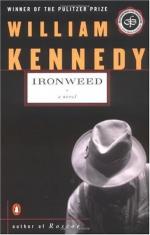
|
| Name: _________________________ | Period: ___________________ |
This test consists of 15 multiple choice questions and 5 short answer questions.
Multiple Choice Questions
1. What does the narrator say is the real basis of the kinship the young Phelan brothers feel with Francis?
(a) Alcoholism.
(b) Family.
(c) Ireland.
(d) Poverty.
2. What day of the year does Ironweed start on?
(a) All Saints’ Day.
(b) All Souls’ Day.
(c) Day of the Dead.
(d) Halloween.
3. What does Helen say will happen to Francis if he leaves her on the street?
(a) She will die.
(b) He will be lost.
(c) He will forget her.
(d) He will freeze.
4. What does Helen say she was doing while Sandra was dying?
(a) Singing.
(b) Sleeping.
(c) Enjoying herself.
(d) Praying.
5. Who was the first man Francis Phelan killed?
(a) Donovan.
(b) Martin Daugherty.
(c) Harold Allen.
(d) Iron Joe Farrell.
6. What does Helen lose on her way back to the Mission?
(a) Her coat.
(b) Her keys.
(c) Her show.
(d) Her purse.
7. What knowledge does Francis say he and Rudy share?
(a) The manners of wanderers.
(b) The rights of homeless men.
(c) The chivalry of drink.
(d) The etiquette of bums.
8. Which of the seven deadly sins prompts Francis to get defensive?
(a) Cowardice.
(b) Greed.
(c) Lust.
(d) Envy.
9. What accusation does the ghost of the first man Francis killed accuse Francis of?
(a) Murdering his baby.
(b) Insanity.
(c) Cowardice.
(d) Selfishness.
10. Where does Helen sleep?
(a) Jack's.
(b) A flop.
(c) Finny’s car.
(d) The Mission.
11. What is Francis guilty about, when he talks to Gerald?
(a) Taking lovers.
(b) Abandoning his family.
(c) Drinking.
(d) Dropping the baby.
12. What is Francis’ reaction when Rudy tells him he is frivolous?
(a) He gets angry.
(b) He insults Rudy genially.
(c) He retreats into enigmatic silence.
(d) He clowns around.
13. Where is Clara when Francis and Helen arrive at Jack’s flat?
(a) On a chamber pot.
(b) On the floor.
(c) In the bath.
(d) In bed.
14. Where does Francis Phelan find his family’s graves?
(a) Among the illustrious dead.
(b) Among the flowing masses.
(c) In the earth and sky themselves.
(d) In the unmarked graves.
15. What is the price Helen pays for sleeping where she does after leaving Clara's house?
(a) A sex act.
(b) She stays for free.
(c) Six dollars.
(d) Two dollars.
Short Answer Questions
1. How does Francis say he behaves when he is drunk?
2. What is Francis afraid will happen to Sandra?
3. How does the narrator characterize Gerald’s eternal repose?
4. Where does Rudy say Sandra came from?
5. What does Francis say about anything that “draws blood or breaks heads”?
|
This section contains 425 words (approx. 2 pages at 300 words per page) |

|




